
This Newsletter presents you the principal events concerning ALADIN during the quarter of year mentioned above. The news about work or events outside Toulouse are related with informations that you sent (for disponibility constraints, the "deported" work deals with the previous quarter).
So, reading this Newsletter, you will know everything about ALADIN activities (more precisely everything I was told about) between October 1997 and December 1997 (except for the work realized outside Toulouse : between July 1997 and September 1997).
Please do bring to my notice anything that you would like to be mentioned in the next Newsletter (number 10) before the 10th of April 1998.
Any contribution concerning announcements, publications, news from the ALADIN versions on workstations or on big computers, verifications results, ... will be welcome. This deadline is particularly important for the report of the deported work each representative should sent every quarter.
If needed, please contact :
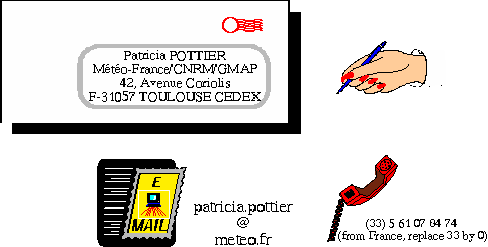
Many thanks for all of you who have sent me most of the informations reported here.
The second assembly of the ALADIN Partners took place in Brussels the 5th of December 1997. Thirteen countries were represented.
Two amendments to the Memorandum of Understanding were unanimously accepted by all Partners. They deal with the conditions of use of the ALADIN software.
The main steps of implementation or development of ALADIN-BELGIUM, ALADIN-FRANCE, ALADIN-LACE and ALADIN-MAROC models were presented. ALADIN-BELGIUM is at the present the operational mesoscale model with the finest resolution in the world. ALADIN-FRANCE whose domain has been extended in order to provide suitable coupling data for Portugal has been declared fit for operational use after a long validation process. The integration of the ALADIN-LACE model in the operational forecasts area is working well : this integration has been tested successfully during the severe floodings events in July 1997. The presentation about ALADIN-MAROC essentially dealt with plans about assimilation of TOVS and radar data.
The switch to ISBA was the main point of the discussion about operational problems (cf. « Major change in the ALADIN code »). The problem of the code maintenance was raised. The necessity for each Members to devote staff to the maintenance and the core developments of ALADIN was pointed out.
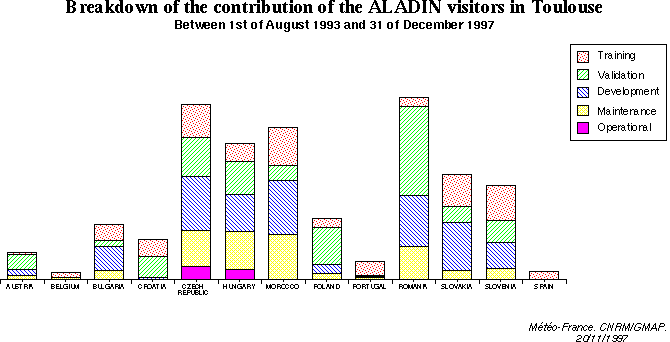
The 1998 ALADIN Partners commitments were presented and the 1997 commitments were assessed : realization at 98%. The project is on continuous growth and development but the report on the evaluation of the ALADIN project also underlined some crucial problems such as the too frequent renewal of the research teams in several countries or the separation between research and maintenance tasks to be devoted to the ALADIN visitors in Toulouse. Among the other main outlooks for the project discussed, the need of a moderate shift of interest from physical parametrization to dynamical and numerical problems appeared.
As an inter-Partners collaboration, Météo-France proposed to ALADIN members a license free of charge for national use of MEDIA model. A collaboration for the development of an ALADIN-MEDIA model for emergency situations was wished by different participants.
A complete report on this second Assembly will be available very soon from the Royal Meteorological Institute of Belgium.
Dr. I. Obrusnik has invited ALADIN Partners for the third Assembly in Praha (Czech Republic) in the beginning of November 1998.
2. A birthday

What could have mobilized one hundred people during one year?
What could have taken a century of hard work for a single poor person?
In a more realistic point of view, what has necessitated 100 person.year?
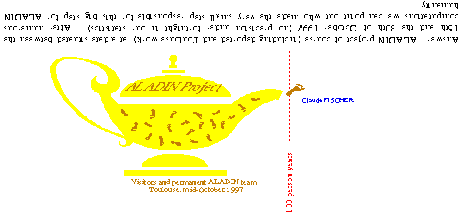
3. Aladin WOrkstation Coordination birth

The main point of the agenda of the last informal ALADIN meeting organized besides the EWGLAM/SRNWP Conference was the discussion on the definition of the AWOC (Aladin Workstation Co-ordination group). Following the comments presented during this meeting, a AWOC definition document has been proposed and four AWOC members have been intrusted : one LACE representative (Jure Jerman from Slovenia), one SELAM representative (Liviu Dragulanescu from Romania) and two representatives from Météo-France (Patrick Le Moigne from GMAP/EXT and Jean-François Estrade from SCEM/TTI/Valparaiso team). The proposed document aims to define the position of the AWOC, its composition and way of working, as well as its main tasks.
4. Emergency-ALADIN over Malaysia
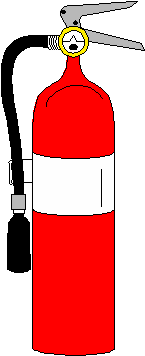
Last October, Malaysia suffered from heavy smoke at large scale caused by burning forest in Indonesia. Link to an humanitarian mission of French people in Lawlessly (including a forecaster from Météo-France), special meteorological products have been made available in Malaysia thanks to the Internet access of the French Embassy. Among these products one set deserves a special attention : fine resolution ALADIN forecasts covering Malaysia and Indonesia.
Due to relatively bad resolution of ARPEGE in this part of the word (about 180 km) at set of 2 ALADIN versions has been installed : a 60 km resolution one getting its ILBC from ARPEGE and coupling a 20 km one. The ALADIN maps (especially precipitations and low level winds, having a large impact on he smoke conditions) where used every day and were judged very useful. The ALADIN/Malaysia suite has run until the 18th of November 1997.
This temporary implementation of ALADIN is double success : the flexibility of the system has allowed us to install the whole suite within 1 day (with an intense involvement of Research Team and Operation Team) ; the quality of the products, despite of the exotic location of the domains, has been assessed by our forecaster and his Malaysian colleagues. This exceptional achievement is highly encouraging for all of us.

1. Conference EWGLAM/SRNWP, Budapest, 6-10 October 1997
The 19th European Working Group on Limited Area Modelling and the 4th Short Range Numerical Weather Prediction Network joint meetings took place in Budapest (Hungary) last 6-10 October.
As usually, presentations from the five main LAM groups in Europe (ALADIN, DWD/SMA, HIRLAM, LACE, UKMO) were followed by national presentations. Then scientific ones essentially related to coupling. A discussion ended this EWGLAM part of the conference.
The SRNWP part of the meeting began with a status report of the lead centres for surface processes and assimilation, variational assimilation, semi-Lagrangian time schemes, non-Hydrostatic modelling, common verification of NWP models. The first two ones proved to work better. A discussion took place on the exchange of code within SRNWP. The question of a SRNWP coordinator was raised.
More information about this conference can be found in the proceedings which should be available soon.
The next conference will be held in Copenhagen in October 1998, 5-10th.
2. Informal ALADIN meeting besides the EWGLAM/SRNWP Conference
On Wednesday 8th of October in the evening, a short ALADIN meeting was organized besides the conference and gave us the opportunity to take stock of ALADIN workstation version (cf. « AWOC ») and ISBA implementation at Météo-France (cf. « Major change in the ALADIN code »).
3. Atelier de Modélisation de l'Atmosphère, Toulouse, 2-3 December 1997

ALADIN model was present in the "Atelier de Modélisation" held in Toulouse, 2nd-3rd December 1997. V. Ducrocq (CNRM/GMME) established diagnostics based on the ALADIN model for convection forecasting. A. Horanyi (Hungary) took stock on the adaptation of 3D-Var technique to ALADIN model. A subjective and an objective validation was presented by J-M Moisselin and M. Tardy (SCEM/PREVI/Compas) : ALADIN appeared better than ARPEGE for most of the parameters controlled.
4. ALADIN Workshop to be held in Toulouse on February 18-20th, 1998 (following)

As explained in the last Newsletter, the different implementations of ALADIN create a new necessity : an increased communication at the technical level between us and a well established coordination for all future evolutions of the code. The proposed workshop will help us to well identify the way how we should work together from now onwards, on the technical point of view (code management, machine dependance, ...). It will benefit from the discussions already organized around the worskstations versions of ALADIN (If. AWOC for the specialists). The workshop will last three days, on the 18th, 19th and 20th February 1998. The first day would be dedicated to oral presentations. Practical activities would be organized during the second day. A one day discussion would conclude the workshop and define a clear strategy on the technical issues. The participation should be typically one person per ALADIN country (possible flexibility on that point).
Please contact Joel.Hoffman++at++meteo.fr for any comments on this proposal.
5. Major change in the ALADIN code (following)

In October 1997, Jean-François GELEYN sent a letter to all ALADIN-Members NMSs' Directors and all ALADIN contact points for operational or pre-operational applications in order to clarify the situation about the potential replacement of the current surface parametrization of ALADIN by the so-called "ISBA" more realistic and advanced scheme. All these ALADIN Contact points should have received a second letter to update the previous one with an up-to-date status of the latest developments, an update proposal "What to do ?". The consequences of the few changes explained in this letter are that we may delay the ISBA exercise by roughly one month but that there is not any more a 100% deadline. Otherwise the need for a unique target date for switching all applications and the consequences of this constraints remain unchanged.
Some mailing also lists exist to make our correspondence smoother (details in the previous Newsletter); for example, the general list aladin++at++meteo.fr.

The funding from the ALADIN-KIT will be used for financing participations to the following meetings : - Workshop in Toulouse (February 1998) - Workshop in Prague (June 1998), - EWGLAM/SRNWP in Copenhagen (October 1998). Please contact joel.hoffman++at++meteo.fr.
2. Embassies support
For 1997 fundings, the last visits supported by the Ministry of Foreign Affairs have been planned until June 1998.
The request for 1998 fundings have been sent to the Minister for most of the countries. More details can be asked to Météo-France/DGS/IE/Arlette Rigaud (arlette.rigaud++at++meteo.fr ).
(more details mehdi.elabed++at++meteo.ma)
2. Operational ALADIN-FRANCE in Météo-France
(more details emmanuel.legrand++at++meteo.fr)
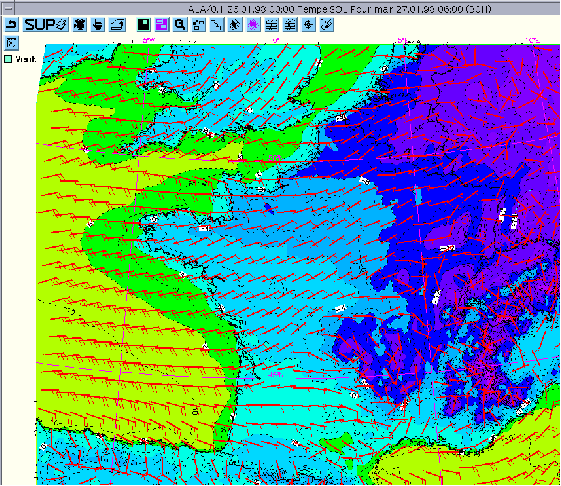
After a long validation process (more details in "Verification of ALADIN-FRANCE), including a 3-month period of intensive study by the central and regional forecasters, ALADIN-FRANCE has been finally declared fit for operational use. Following technical steps have been made:
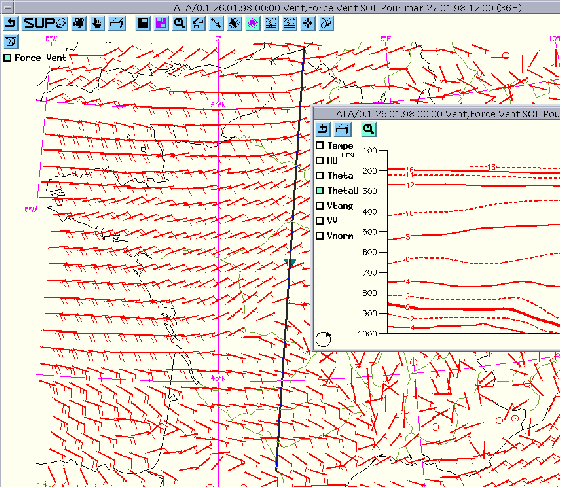
Two actions still need to be completed:
Further news in the next newsletter...
3. Pre-Operational ALADIN-LACE in Météo-France
(more details bubnova++at++chmi.cz)
4. The operational implementation of ALADIN-BELGIUM
(more details luc.gerard++at++oma.be)
5. Future ALADIN-LACE in CHMI
(more details : janousek++at++chmi.cz)
Very few changes for the other versions since the (comprehensive) reports presented in the last Newsletter. You will be told everything about the workstations version of ALADIN in the next Newsletter with the additional report of ALADIN Workshop to be held on workstation versions of ALADIN.
1. Workstation version at the Instituto de Meteorologia (Portugal)
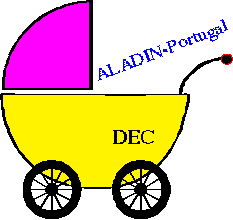
(more details mario.almeida++at++meteo.pt)
The ALADIN version 7 has been installed on a DEC Workstation (operating system OS/1-V4.0). The choice of a correct configuration and the usage of several facilities within ALADIN including the CANARI option in a workstation environment have been made easier thanks to Liviu Dragulanescu 5-day visit. The next step is the creation of climatological files corresponding to the new geographical zone.
2. Workstation version at Hungarian Meteorological Service
(more details horanyi++at++met.hu)
As it was mentioned in the last Newsletter the Hungarian Meteorological Service decided to purchase a DEC 600 Au Personal Workstation for running the workstation version of ALADIN on it. The most important characteristics of this workstation are as follows:
CORNERS:
RESOLUTION: 10.89 km
The model will be coupled by ALADIN/LACE (the coupling files are produced in Toulouse since 19th November, 1997) and the climatological files were also prepared. According to our plans we would like to put the workstation version of ALADIN into operations (having integrations twice a day for 48 hours) in the near future.
3. Workstation version at Slovenian Meteorological Service
(more details mark.zagar++at++rzs-hm.si)
The quasi-operational activity at HMIS went on in the last quarter of 1997. Existing morning suite of ALADIN/SI has been complemented by the afternoon suite, having exactly the same time schedule. Due to the improved operational script of ALADIN/LACE in Toulouse, which prepares the national subdomain for Slovenia parallely with the integration of the model, ALADIN/SI now starts at 03:01 UTC and finishes at 04:23 UTC (+12 hrs for the afternoon run). The cycle 7 of the code is being used for operational purpose. The model outputs are appearing on visualization system in parallel with model run. Forecast of ALADIN/SI is presented to the forecaster and every interested person at HMIS in several ways: as fields of variables at different levels, as point forecast by stations and variable (particularly 2m temperature and precipitations) and as forecast infra-red satellite image. All this information is available at IntraNet and is best viewed by an http viewer. The same visualization is now used for ALADIN/LACE results as well, and is based on NCAR graphics package. You can have a look at some public available products at http://www.rzs-hm.si/napoved/aladin.html. For detailed wind forecast at the resolution of 2.5 km the dynamic adaptation of ALADIN/SI and ALADIN/LACE forecast can be performed on demand. Tkcs X window interface for ascs has been developed by Gregor Gregoric. It is installed also on Andante, have a look in ~mrpe694/cs/README for instructions.
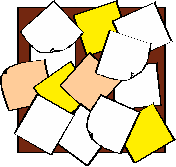
The above list is a preliminary list of scientific topics to be covered in 1998 as far as ALADIN is concerned. The list was compiled by Jean-Francois Geleyn with the help of Andras Horanyi and it is emphasized that it is a preliminary one as far as the subjects and also the persons are concerned. It is possible that some interesting and/or important topics were forgotten, so you are kindly asked to contact them in that case. It is also asked to propose some persons for those topics where there are no names or question marks can be found.
An extra level of coordination is desirable in the following topics: variational data assimilation, non-Hydrostatic, modelling and the lateral boundary condition problem. In these subjects both coordinators were nominated : one from Météo-France side and one on the behalf of the other ALADIN countries.
1. DATA ASSIMILATION
| Scientific topics to be covered in 1998 | Proposed names |
| Adapt the Jb term from ARPEGE/IFS (statistical balance) to ALADIN | L. Berre (France)
M. Siroka (Slovakia) |
| Possible use of incremental/decremental approach together with spectral coupling in 4DVAR; if not problem of the consistency of 4DVAR strategies between the coupling model and the coupled one | V. Ivanovici (Romania)
L. Dragulanescu (Romania) |
| Incremental DFI in coupled data assimilation mode | V. Ivanovici (Romania)
L. Dragulanescu (Rom.) W. Sadiki (Morroco) |
| Extension of DFI to grid-point variables for a potential use in spectral coupling mode and in 3.5DVAR | ???
D. Giard (France) |
| Scientific study of sensitivities of forecast errors to initial and lateral boundary conditions ("poor man's 4DVAR") | C. Soci (Romania)
L. Dragulanescu (Romania) |
| Study the balance requirements for variational dat assimilation | S. Issara (Morroco) |
| Single observation experiments using optimal interpolation (CANARI) | E. Cordoneanu (Romania)
C. Soci (Romania) |
| Calculation of observation errors using the Hollingsworth-Lonnberg technique | Y. Wang (Austria) |
| Refinement of observation operators for ALADIN | L. Gaytandjieva (Bulgaria) |
| Impact of surface analysis, with CANARI and ISBA in ALADIN | M. Zitouni (Croatia) |
| 4DVAR experiments using simplified physics | M. Janiskova (Slovakia) |
| Diagnostics on the calculation of background error covariances using the NMC method | M. Monteiro (Portugal) |
| ISBA in CANARI, relative humidity from TOVS data | S. Issara (Morocco)
R. Ajjaji (Morroco) |
2. DYNAMICS
| Scientific topics to be covered in 1998 | Proposed names |
| Technical problems related with the TL and AD of the non-Hydrostatic SL dynamics | M. Charron (Canada)
M. Janousek (Czech R.) |
| Calculation of singular vectors using Lanczos algorithm (configuration 601) | F. Chome (Belgium) |
| SL version of the elastic version of the model | M. Janousek (Czech R.)
R. Bubnova (Czech R.) |
| Increased sophistication of the "free-slip" lower boundary condition for the elastic version of the model | R. Bubnova (Czech R.) |
| Introduction of the SL formalism for the lower boundary condition | D. Eemas (Slovenia) |
| Relaxation of the thin layer hypothesis and simultaneous introduction of the vertical part of the Coriolis force | D. Dvorak (Czech R.) |
| Study of the coupling between a hydrostatic coupling model and a non-Hydrostatic coupled one | F. Prates (Portugal) |
| Trial of linear (semi-linear) grids | M. Marku (Albania) |
| Experiments with increased vertical resolution | M. Caian (Romania)
E. Zsoter (Hungary) J. Boutahar (Morroco) |
| Experiments using spectral coupling | M. El Abed (Morroco) |
| 1D vertical model | M. Zagar (Slovenia) |
| Conservation properties of a two-time level semi-implicit SL scheme | I. Gospodinov (Bulgaria) |
| Dynamical and physical control of kinetic energy spectra | F. Vana (Czech R.) |
| Radiative upper bundary conditon for accustic waves | J. Vivoda (Slovakia) |
| Interaction between orography and gravity wave drag | R. Mladek (Czech R.) |
| TL of post-processing | L. Dragulanescu (Romania) |
3. PHYSICS
| Scientific topics to be covered in 1998 | Proposed names |
| Extension of the physics to the non-Hydrostatic framework | L. Gerard (Belgium) |
| Introduction of ozone as prognostic variable | Some interest from Croatia |
| More sophisticated treatment of the radiative propertiesof the clouds | C. Madeira (Portugal)
J.-M. Piriou (France) |
| Exploration of the evolution towards higher order closure representation of the turbulence | D. Dufkova (Czech R.)
E. Bazile (France) |
| Study of the problem of internal downdrafts (also as a potential replacement for a separated parametrisation of shallow convection) | T. Haiden (Austria) |
| Cloudwater as prognostic variable | D. Banciu (Romania) |
| CROCUS, snow model | V. Spiridonov (Bulgaria) |
| Closure for convection | M. El Abed (Morocco) |
| Intercomparison of physical parametrization packages | J. Vivoda (Slovakia) |
4. COORDINATORS:
|
|
|
|
|
|
|
|
|
|
|
|
|
|
|
|


This situation was studied thanks to the successive nesting : ARPEGE integration started with ECMWF reanalysis; a first ALADIN integration over a domain of 2000 x 2000 km with a mesh size about 12 km; a second ALADIN integration over a smaller domain (1200 x 1200) with an increased horizontal resolution (~7km).
The structure and the development of the simulated squall line were compared to satellite and radar data analysis. Nuclei of associated downward and upward motion have been correctly simulated (cf the vertical cross-section over South Germany obtained without -OBS2, and with -OBS3, downdraft parametrization). The effect of the downdraft parameterization was greater than for other situations, probably thanks to better initial conditions.
But although the squall line was correctly simulated, the surface wind velocity had smaller values than the observed ones. More verifications are necessary to evaluate the real effect of downdraft parameterization.
SYNOP surface station cloud amount observations at some Austrian locations and total cloudiness predictions of operational ALADIN-LACE and ECMWF were compared on a simple point-to-point basis. The idea is to learn more about the strengths and weaknesses of the cloudiness parameterization in ALADIN in order to see where improvement are needed most. The results presented below are, however, preliminary and are to be followed by a more in-depth analysis.
The evaluation included 7 stations at major cities, with two of them
located within the Alps (Innsbruck, Klagenfurt), two at the Alpine rim
(Graz, Salzburg), and three in lowland areas (Linz, St.Pölten, Vienna).
The period studied was 97/06/12 to 97/12/31 (203 days), evaluation times
were 06, 12 and 18 UTC. Occurrences of ground fog were excluded from the
statistics. Table 1 shows the rms errors at these stations for ALADIN and,
for comparison, the rms error of the ECMWF short-range forecast. Both grid-point
fields were interpolated bilinearly to the station locations.
|
Station |
|
|
|
|
|
|
|
|
|
|
|
|
|
|
|
|
|
|
|
|
|
|
|
|
|
|
|
|
|
|
|
|
|
|
Table 1 : Root-mean-square error (in octas) of short-range total cloudiness predictions
by ALADIN-LACE and by ECMWF for some Austrian stations.
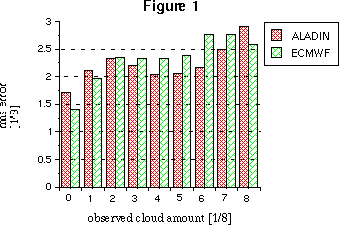
On average, ALADIN gave slightly better point predictions than ECMWF, mainly due to higher skill at the lowland stations. Largest errors were found for Klagenfurt in both models. Inspection of contingency tables for observed vs. ALADIN total cloudiness reveals that in Klagenfurt there is a higher number than at other stations of cases with 0-1/8 predicted and 7-8/8 observed. Closer analysis shows that in most of these cases there was high inversion fog (low stratus, low stratocumulus) present, covering valleys and lowlands, with mountain stations reporting at the same time much less, or even zero, cloud cover. The ALADIN predictive skill at such occasions is improved significantly when only the cloud amount observed outside the boundary layer is used for comparison.
Figure 1 shows results of all stations combined, and stratified according to observed cloud amount. While ALADIN performs better than ECMWF in the range 3-7/8, the forecast of zero and full cloud cover are less satisfactory. It is basically due to ALADIN predicting more frequently than ECMWF 1-2/8 cloudiness when there actually was none, and 6-7/8 when full cover was observed. Further investigation is required to determine the synoptic settings in which these cases occur.
For the operational forecaster it is useful to know the reliability
of a prognostic variable as a function of its predicted value (rather than
the observed one), because it is the only value available a priori. In
practice the most essential distinction is between little cloudiness, including
clear sky, medium cloudiness, and near or full overcast. Accordingly, we
lump together cloud amount values into the three equally sized ranges 0-2,
3-5, and 6-8 octas, and determine the probability of the observed amounts
falling into the predicted ranges (Table 2).
|
|
|
|
|
|
|
|
|
|
|
|
|
|
|
Table 2 : Probability p (in %) of different model forecasts being true.
There are large differences of forecast reliability between different ranges. The greatest amount of information seems to be contained in the 6-8/8 forecast which for both models holds true in more than 80 % of cases. In the 0-2/8 range, ALADIN forecasts are significantly more reliable than those of the ECMWF. Note that for medium (3-5/8) cloud amount predictions, the reliability of both models is extremely low. It follows that there is a systematic deficiency in the parameterization of total cloudiness in the models. In the majority of these incorrect, medium prediction cases, actual cloud cover was 7-8/8, caused by elevated fog layers that where not present in the models. The fact that these layers of low stratus often occur when there is little upper cloudiness may explain the negative correlation between forecast and observation.
It is important to note that the simple point-to-point rms calculation applied here favours smooth, low variance fields. Thus, in a case where the spatially and temporally more variable ALADIN forecast manages to achieve the same rms as the corresponding ECMWF field, it is very likely superior with regard to field structure and patterns. It should also be stressed that the period studied is too short to reveal actual model climatology.
ALADIN-FRANCE is a limited area model wich uses ARPEGE initial and boundary conditions. The maximum forecast range is 36H.
Before ALADIN-FRANCE intensive period of validation at Météo-France by national and regional forecasters, many studies have proved the impact of the model, compared to ARPEGE. For example, the "Cas de Béziers" showed the capacity of ALADIN to forecast massive precipitations.
During the three months period of intensive validation at Météo-France from 1996/12/01 to 1997/02/28, regional centers and central center forecasters had to choose between ARPEGE and ALADIN-FRANCE (subjective validation). The question was "in an operational context what model do you choose". The "equal" choice were excluded and forecasters had 4 choices.
Most of judgements were "ALADIN better" or "ARPEGE better". Only 1% of the judgement were "ALADIN much better" or "ARPEGE much better".
Next figure shows that forecasters choose more often ALADIN, even at the 36H forecast range.
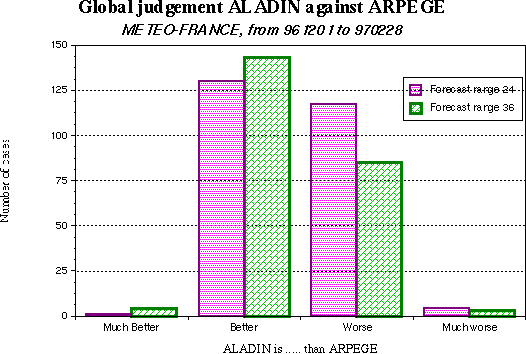
The results are quite the same for the objective validation : there are no big differences between ARPEGE and ALADIN but ALADIN is almost always better than ARPEGE (except for precipitations during the validation period)
The scores (bias and root mean squared error) plotted on the figure on the next page correspond to the scores calculated against surface observations SYNOP over the domain ALADIN-FRANCE (FRANP01). Scores are averaged over the last three month of 1997, for each 6 hours time-step. RMS and bias are the average of the daily RMS and bias (weighted by the number of observations).
Some comments :

In the next two parts ("Deported developments during the third quarter of 1997" and "ALADIN developments in Toulouse during the last quarter of 1997"), you will find the list of the ALADIN developments (in and outside Toulouse) excepted those detailed in the previous pages : PhD studies, developments for workstation versions or operational suite, work on data assimilation, ... during the quarters concerned by this Newsletter. The following informations concerning the deported developments are obtained from informations you sent.
1. In Austria
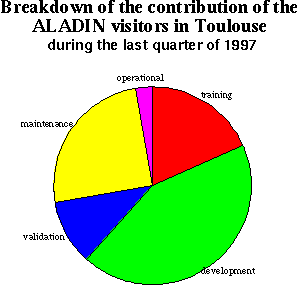
With the AL08 version of the code, one could hardly recognize his usual ALADIN model. Major changes inside the code and in the compilation orders have been introduced.
This huge work involved the energy of many of our visitors (R. Bubnova, D. Dvorak, M. El Abed, A. Horanyi, M. Janiskova, M. Janousek, J. Jerman, G. Radnoti, M. Siroka, O. Spaniel) or Toulouse members of ALADIN team (D. Giard, C. Fischer, P. Le Moigne) with the help of others people from CNRM/GMAP or SCEM/TTI.
Meanwhile, the others visitors dealt with their training, different developments, validation studies, ...
1. The new version AL08 : a brief overview by C. Fisher

From October 20th to December 10th, an important effort has been performed in Toulouse, in order to achieve the new cycle AL08 of ALADIN. Some twenty persons were involved, both among French support team and from the ALADIN partner countries. Besides the scientific developments (especially the implementation of the ISBA soil parametrization), the two main aspects of the new cycle concerned :
Finally, I want to thank here all those who have given part of their time and participated in this necessary phasing effort. And I look forward to seeing them or fellow ALADIN-users at the next phasing ...
2. Research and development studies
which has very big value over mountains. Experiments with new Kuo's closure, new entrainment rate, exchange order of stratification and convection were carried out. It has desirable effect. As a good solution seems to be CAPE based closure but best results were obtained with relaxation time 30600 seconds, what is extremely high value (and unexpected). Tuning of CAPE closure is next step of this work.
3. HERA activities in GMAP : Richard Mladek and Jean Barckicke
As previously explained, HERA is a project of systematical intercomparison of forecasts of precipitations in the frame of MAP. The model data fields have been partly received in Toulouse. A pre-processing of the data was necessary to have raw model comparable with the measurements. Using these elaborated data, the procedures to compute global scores and contingency tables are now available. They will be applied to the data of the different models to be compared.
4. RETIC activities in GMAP : Patrick Le Moigne
In the framework of the RETIC (Reseau de Transfert Interne des Connaissances), the action called B95 is now under development. The aim of this action is to prepare a surface wind climatology at fine scale. The automatic classification is the starting point of the study, its result is a repartition of the different weather types into several classes. Then the second phase consists in modelling the different classes, using ALADIN-FRANCE model (mesh size of 12.71 Km). Finally, in the third phase, Meso-NH model, initialized with ALADIN-FRANCE data will simulate surface wind at a resolution of 1 Km. The second phase of the action has just started now, with the simulation of recent cases to compare the results of ALADIN + Meso-NH with observations.
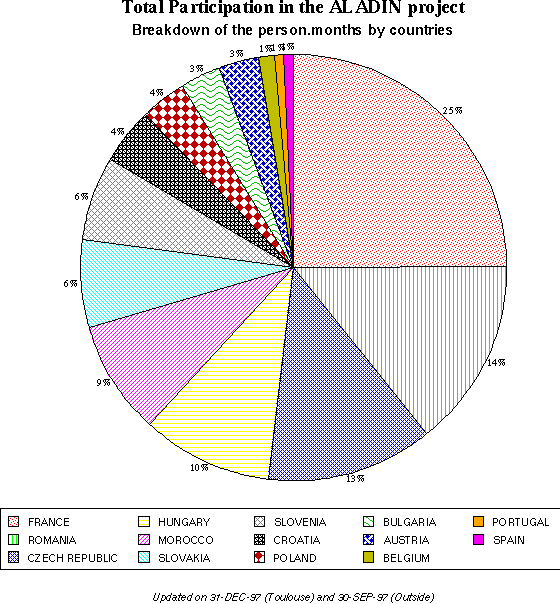
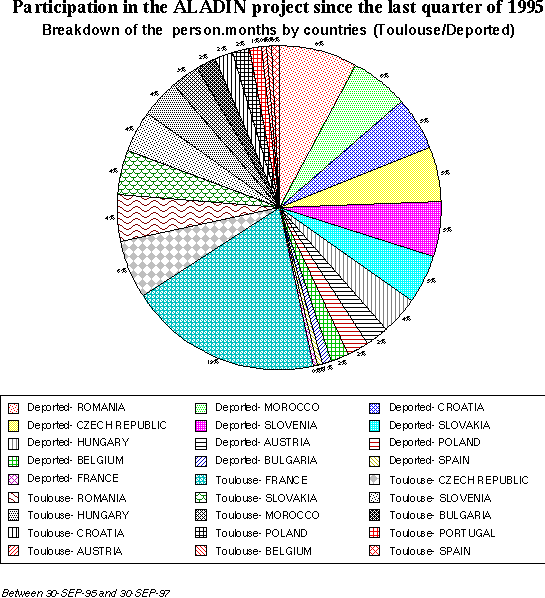
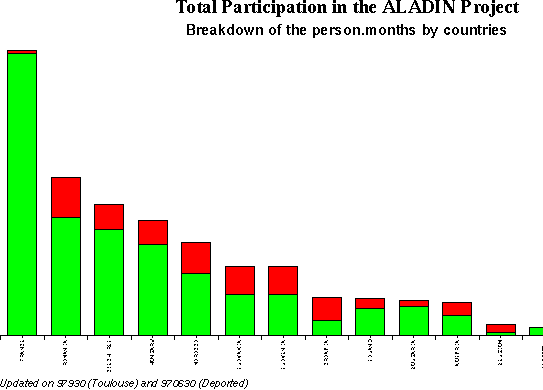
 |
Home |